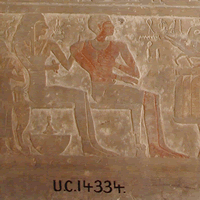| Homepage | Timeline | Maps | A-Z index | Learning |
Jewellery in the Middle Kingdom
(about 2025-1700 BC) and Second Intermediate Period
(2025-1500 BC )
 |
Detail of stela UC 14334 . Roll-over the image to highlight the jewellery shown on the monument (or click here). Similar jewellery has been found in Middle Kingdom burials as illustrated below. |
| The broad collar is very often shown in two and three dimensional art. It is common in elite burials, but not in tombs of people of lower status. |
| Simple necklaces are very often found in tombs but only rarely shown in art. |
| Strings of beads and amulets were often worn at the ankles and wrists. |
|
Semi-precious stones (amethyst) are very popular in
the Middle Kingdom (about 2025-1700 BC).
|
|||
The quality of jewellery produced in the Middle Kingdom (about 2025-1700 BC) was not surpassed
in earlier or later times. New techniques for gold working were introduced
such as granulation (most probably from the Near East).
| Gold cylinder from Harageh. The decoration is made in granulation. It is one of the earliest examples of this technique found in Egypt. | |
| Gold fish amulet from Harageh. A typical object type found in late Middle Kingdom tombs. Similar amulets were represented in art and one is even mentioned in literature (the Egyptian word being nekhkha). |
compare: